Back to: Red Sea Reef Slope 3 of 5, On
to: Red Sea Reef Slope 5 of 5
Spiny Skinned Animals, phylum Echinodermata. The Red Sea has
an abundance of species of all the living classes of echinoderms, with
crinoids (Feather Stars) and if you look close, Brittlestars
(ophiuroids) in abundance. These two groups and the too-large Sea
Cucumbers (holothuroideans) from here are either largely ignored by the
trade or incidental in importance. The other echinoderm classes, the
Sea Urchins and Seastars are of more interest.
| Fromia ghardaqana Mortensen 1936,Ghardaqa
Brittle Star. Red Sea endemic. To three inches in diameter. A
few other Fromia spp. Seastars are found here; all make great reef
aquarium specimens. |
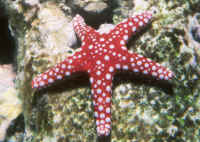
|
| Gomophia egyptica Gray 1840, Eqyptian
Brittlestar. Indo Pacific; Red Sea to the South Pacific. Needs
shade, calcareous rocks which it feeds on the life on. Here in the
Red Sea. |
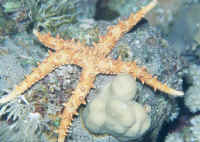
|
| Asthenosoma varium Grube 1866, the Pinhead
Sea Urchin. Family Echinothuriidae. Indo-West Pacific; Red Sea to
Indonesia. Test size to six inches in diameter; spines to twelve.
Nocturnal, not safe kept with other invertebrates or handled with
bare hands. Walks on spines and/or tube feet. Takes all foods. This
one in the Red Sea. |
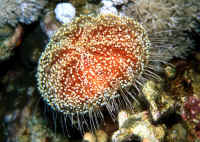
|
| Diadema setosum (Lske 1778), the Hatpin
Urchin. Indo-Pacific; Red Sea to South Pacific, Japan. To about
four inches in diameter. Useful in coral bearing aquariums as these
echinoids avoid their rocks. A frequent "contaminant" on
live rock imports. Fiji nighttime image. |
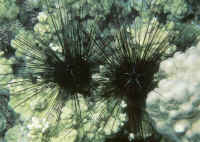
|
| Echinometra mathaei (Blainville 1825), the
Common Urchin. Indo-Pacific; Red Sea to Hawai'i. To about four
inches overall diameter. Hides by day in rocky crannies it helps
gouge. Mostly eats algae it rasps from rocks by night. Here in
Oahu, Hawai'i by day and Fiji at night. |
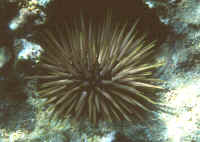 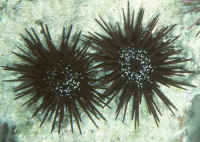
|
| Echinothrix calamaris (Pallas 1774), the
Hatpin Urchin. Indo-Pacific; Red Sea to Hawai'i. Should be kept
singly and may prey on cnidarian livestock. Need large spaces in
rock to hide amongst by day and coarse substrate. Cebu, Philippines
and Hawai'i images. |
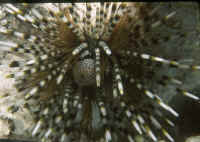 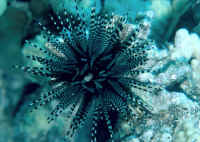
|
| Tripneustes gratilla (Linnaeus 1758), the
Priest-Hat or Collector Urchin. Family Toxopneustidae.
Indo-Pacific; Red Sea to Hawai'i. Toxic to the touch to sea
life. To about five inches in diameter overall. Mentioned so
hobbyists will avoid it. A specimen in the Red Sea at night |
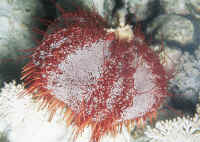
|
| Microcyphus rousseaui (Agassiz & Desor
1846), Rousseau's Sea Urchin. Western Indian Ocean; Red Sea to
eastern Africa. Shallow water (0-5 meters), mainly on upper reef
slope. Nocturnal, feeds on algae and sessile invertebrates. To
three inches in diameter. Red Sea image. |
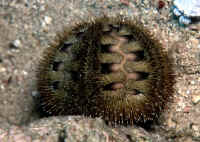
|
Sea Squirts, Ascidians.
| Botrylloides species. Row Encrusting
Tunicate. Tropical western Pacific to the Red Sea. Low growing
colonies with distinctive rows of individuals and round chimneys.
Red Sea images. |
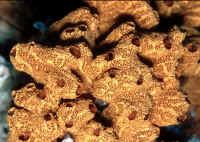 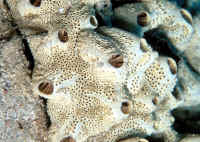
|
| Didemnum moseleyi Herdman 1886,
Moseley's Sea Squirt. Tropical Indo-West Pacific, including the
Red Sea. Encrusts rocks in brightly lit areas to 25 meters depth.
Not easily kept. Must be collected with substrate attached. Red Sea
image. |
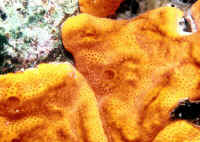
|
Principal Fishes of the Red Sea Sandy
Reef Slopes: (Species commonly available, and useful for
aquariums.)
Per the general "rule" of greater
habitat diversity, the more species abundance, the reef slopes are the
areas of greatest mix of species and density. When planning and
selecting your livestock mix, bear in mind the "sub-niches"
of the fishes available to you, and provide space, habitat
accordingly. Again, this is not an exhaustive listing, but only a
guide to the species mainly found on Red Sea reef slopes that are of
use and generally available to aquarium hobbyists.*
Moray Eels, family Muraenidae: Though of the 27 species
recorded from here there are some small members, really only
Gymnothorax griseus is common, appropriate for aquarium
use.
| The Gray Moray, Gymnothorax
(Siderea) griseus (Lacepede 1803), is a small (three
foot max.) compatible species, though expensive; hailing from the
Red Sea and west Indian Ocean. Red Sea photo. |
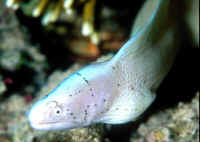 |
Soldierfishes, family Holocentridae. Fifteen Red Sea Species.
Two species are common, often on offer: Myripristis murdjan and
Neoniphon sammara. Sargocentron spiniferum is a regular resident,
but gets too large for most aquarium use.
| Myripristis murdjan
(Forsskal 1775), the Pinecone Soldierfish. Indo-Pacific through
Oceania. This one photographed in the upper Red Sea where it is
caught for the European hobby. To one foot total
length. |
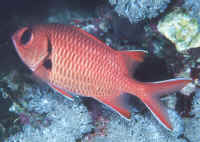
|
| Neoniphon sammara (Forsskal
1775), the Sammara Soldierfish. Indo-Pacific, Red Sea to the
Hawaiian Islands. To about a foot long. An occasional import. Red
Sea image. |
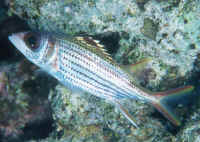
|
Lion- or Scorpionfishes, family Scorpaenidae: Of the more
common species in the Red Sea, the Radiata Lion is the one most often
encountered (within rock caves by day, hunting about them and the
bottom edge of the slope by night).
|
Pterois radiata Cuvier
1829, the Two-Bar Lion is the Radial Firefish. The most
chameleonic of lions showing overtones of green, black and
various shades of red over shocking white. The salient
identifying characteristic of this species is the two while
horizontal bars on the caudal peduncle, the part of the body
right before the tail. Red Sea specimen. To nine
inches.
|
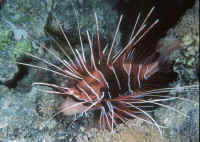
|
Basses, family Serranidae. Cephalopholis argus, C.
miniata, Epinephelus fasciatus, Variola louti and others are
regularly found in pet fish stores. Others like members of the genus
Plectropomus get way too big.
| Cephalopholis argus Bloch & Schneider
1801, the Peacock or Argus Hind or Blue-Spotted Grouper.
Indo-Pacific, Red Sea to French Polynesia. Introduced into
Hawai'i and the tropical eastern Pacific coast as a food and
game fish. To a foot and a half in length. Make
excellent aquarium specimens for large fish-only
systems. |

|
| Cephalopholis
miniata (Forsskal 1775), the Miniata Grouper, Coral
Hind. Indo-Pacific: Red Sea to the Line Islands. To eighteen inches
in length. Undoubtedly the most prized, frequently used member of
the genus for aquariums. A beauty that is intelligent, and capable
of gulping up small fishes and motile invertebrates. Red Sea
image. |

|
| Variola louti (Forsskal 1775), the Skunk or
Yellow-Edged Lyretail Grouper. Indo-Pacific to the Pitcairn
Islands, and including the Red Sea. To thirty inches in length.
Pictured are a four inch juvenile, eighteen inch and two foot
individuals in the Red Sea. |
Basslets, subfamily Anthiinae: These are the "signature
fishes" of the Red Sea. If you're in the Red Sea on the Reef,
you're looking at Basslets. Two species in particular:
| Pseudanthias squamipinnis (Peters 1855), the
Lyretail Anthias. Red Sea to western Pacific. To four and a half
inches in length. A tough, but sometimes mean aquarium species.
Male and females shown Aquarium and Red Sea. |
 
|
| Pseudanthias taeniatus Klunzinger 1884, the
Striped or Red Sea Anthias. A Red Sea endemic. To five inches
overall length. A male (with the white lateral stripe) and female
shown, photographed at Sharm el Sheik. Formerly placed in the genus
Anthias. |
 
|
Soapfishes, family Grammistidae. Diploprion drachi and
Grammistes sexlineatus are sold in the trade, and though
secretive, stay small, are pretty.
| Diploprion drachi Roux-Esteve 1955, the
Yellowfin Soapfish. Red Sea (where this picture was taken) and Gulf
of Aden. To five and a half inches in length. Shy species that
hides near rocky reefs and masks behind larger fishes to sneak up
on fish prey. |

|
| Grammistes sexlineatus (Thunberg 1932), the
Sixline Soapfish or Grouper. Indo-Pacific, including the Red Sea.
To twelve inches in length. For calm surroundings with caves, of
adequate size, that are well-filtered . A juvenile in the Red
Sea and adult in captivity. Monotypic genus. |
 
|
Roundheads, family Plesiopsidae. Of the four species of the
family found here, Calloplesiops altivelis is readily available
to aquarists. Do keep your eyes open for the gorgeous C.
coeruleolineatus which may be ordered from specialty dealers like
Marine Center.
| Calloplesiops altivelis Steindachner 1903,
the Comet or Marine Betta. Indo-Pacific, including the Red Sea. To
a bit over six inches. A shy species that requires a dark cave and
peaceful tankmates to thrive. Aquarium image. |
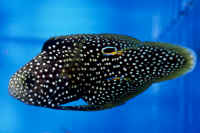
|
Cardinalfishes, family Apogonidae. Fifty four species are
described from the Red Sea. Of these, Apogon aureus is a beauty
that schools, stays out in the open, is readily found in the hobby...
Other more secretive, solitary, but occasionally available Cardinals
from here are A. fraenatus, A. kallopterus, A.
leptacanthus and A. macrodon. The first two and last
best kept in a group of several individuals, fraeatus and kallopterus
find singly.
| Apogon aureus (Lacepede
1802), the Ring-Tail Cardinalfish. Indo-Pacific; Red Sea, east
Africa to New Caledonia. To nearly five inches in length. This
mouthbrooding male in the Gulf of Aqaba, Red Sea. |
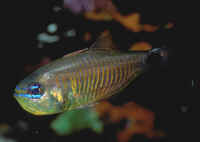
|
| Apogon fraenatus
Valenciennes 1832, the Bridled Cardinalfish. To four inches in
length. Indo-Pacific; from Durban, South Africa to Tuamotus. Image
from Fiji at night. |
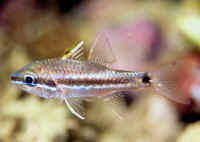
|
| Apogon kallopterus Bleeker
1856, the Iridescent Cardinalfish. Indo-Pacific, including the Red
Sea (where this one was photographed at night while foraging). To
six inches in length. A larger specimen out during the day in the
Maldives also shown. |
 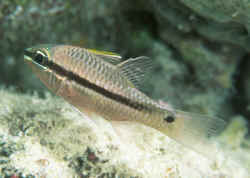
|
| Apogon leptacanthus Bleeker
1856-57, Threadfin Cardinalfish. Indo-Pacific including the Red
Sea. To a little over two inches in length. Found in dense school
in the wild. This group in a friends aquarium. |
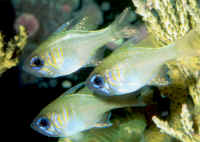
|
Back to: Red Sea Reef Slope 3 of 5, On
to: Red Sea Reef Slope

